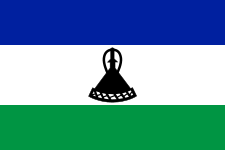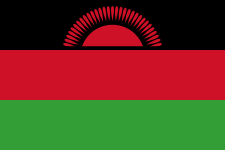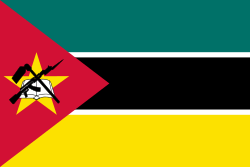Southern African Development Community
Southern African Development Community (SADC) Communauté de développement d'Afrique australe Comunidade de Desenvolvimento da África Austral |
||||||
|---|---|---|---|---|---|---|
|
||||||
| Motto: "Towards a Common Future" | ||||||
| Anthem: SADC Anthem | ||||||
 Map of Africa indicating SADC (light green) and SADC+SACU (dark green) members.
|
||||||
| Headquarters | Gaborone, Botswana | |||||
| Working languages | ||||||
| Type | Intergovernmental | |||||
| Membership | ||||||
| Leaders | ||||||
| - | Summit Chairperson | |||||
| - | Council Chairperson | |||||
| - | SADC PF Chairperson | |||||
| - | Tribunal President | |||||
| - | Executive Secretary | |||||
| Legislature | SADC Parliamentary Forum | |||||
| Establishment | ||||||
| - | as SADCC | 1 April 1980 | ||||
| - | as SADC | 17 August 1992 | ||||
| Area | ||||||
| - | Total | 9,882,959 km2 3,815,832 sq mi |
||||
| Population | ||||||
| - | estimate | 277 million | ||||
| GDP (PPP) | 2013 estimate | |||||
| - | Total | US$ 1,193 billion | ||||
| - | Per capita | 4,309 | ||||
| Time zone | (UTC+1 to +4) | |||||
| Website www |
||||||
The Southern African Development Community (SADC) is an inter-governmental organization headquartered in Gaborone, Botswana. Its goal is to further socio-economic cooperation and integration as well as political and security cooperation among 15 southern African states. It complements the role of the African Union.
Member states
 |
| This article is part of a series on the politics and government of the African Union |
|
Executive
|
|
Legislature
|
|
Advisory bodies
|
|
Financial bodies
|
|
Decentralised bodies
|
|
Related topics
|
|
Politics portal |
SADC has 15 member states:
 Angola
Angola Botswana
Botswana Democratic Republic of the Congo – since 8 September 1997
Democratic Republic of the Congo – since 8 September 1997 Lesotho
Lesotho Madagascar – membership reinstated on 30 January 2014 [1] after an imposed suspension in 2009
Madagascar – membership reinstated on 30 January 2014 [1] after an imposed suspension in 2009 Malawi
Malawi Mauritius – since 28 August 1995
Mauritius – since 28 August 1995 Mozambique
Mozambique Namibia – since 31 March 1990 (since independence)
Namibia – since 31 March 1990 (since independence) Seychelles – also previously been a member of SADC from 8 September 1997 until 1 July 2004 then joined again in 2008.
Seychelles – also previously been a member of SADC from 8 September 1997 until 1 July 2004 then joined again in 2008. South Africa – since 30 August 1994
South Africa – since 30 August 1994 Swaziland
Swaziland Tanzania
Tanzania Zambia
Zambia Zimbabwe
Zimbabwe
History
The origins of SADC lie in the 1960s and 1970s, when the leaders of majority-ruled countries and national liberation movements coordinated their political, diplomatic and military struggles to bring an end to colonial and white-minority rule in southern Africa. The immediate forerunner of the political and security cooperation leg of today's SADC was the informal Frontline States (FLS) grouping. It was formed in 1980.
The Southern African Development Coordination Conference (SADCC) was the forerunner of the socio-economic cooperation leg of today's SADC. The adoption by nine majority-ruled southern African countries of the Lusaka declaration on 1 April 1980 paved the way for the formal establishment of SADCC in April 1980.
Membership of the FLS and SADCC sometimes differed.
SADCC was transformed into SADC on 17 August 1992, with the adoption by the founding members of SADCC and newly independent Namibia of the Windhoek declaration and treaty establishing SADC. The 1992 SADC provided for both socio-economic cooperation and political and security cooperation. In reality, the FLS was dissolved only in 1994, after South Africa's first democratic elections. Subsequent efforts to place political and security cooperation on a firm institutional footing under SADC's umbrella failed.
On 14 August 2001, the 1992 SADC treaty was amended. The amendment heralded the overhaul of the structures, policies and procedures of SADC, a process which is ongoing. One of the changes is that political and security cooperation is institutionalised in the Organ on Politics, Defence and Security (OPDS). One of the principal SADC bodies, it is subject to the oversight of the organisation's supreme body, the Summit, which comprises the heads of state or government.
The organisation holds its own multi-sport event in the form of the SADC Games, which was first held in 2004 in Maputo. Originally planned for an earlier date in Malawi and Lesotho, organisational issues led to abandonment of the plan and the SADC issuing a fine of $100,000 against Malawi.[2] The first event in 2004 in Maputo resulted in over 1000 youths under-20 from 10 countries taking part in a sports programme including athletics, football, netball, boxing and basketball.[3]
SADC Protocols
SADC has 27 legally binding protocols dealing with issues such as Defence, Development, Illicit Drug Trade, Free Trade and Movement of People.[4]
- Protocol on Energy (1996) - Intended to promote harmonious development of national energy policies. These development strategies set out tangible objectives for SADC and its Member States for infrastructure development in energy and its subsectors of woodfuel, petroleum and natural gas, electricity, goal, renewable energy, and energy efficiency and conservation. [5]
- Protocol on Gender and Development - Member states are urged to accelerate implementation efforts towards the achievements of concrete and transformative changes in the lives of women and girls in our region.H.E. President Mutharika also expressed concern on the escalating incidents of gender based violence in the region, especially those perpetrated against women and girls, and used this occasion to sign a commitment to end child marriages, as part of the AU campaign to end Child Marriages in Africa.[6]
SADC FTA
The SADC Free Trade Area was established in August 2008, after the implementation of the SADC Protocol on Trade in 2000 laid the foundation for its formation.[7][8] Its original members were Botswana, Lesotho, Madagascar, Mauritius, Mozambique, Namibia, South Africa, Swaziland, Tanzania, Zambia and Zimbabwe,[9] with Malawi joining later. Of the 15 SADC member states, only Angola, the Democratic Republic of Congo and Seychelles are not yet participating.[10]
On Wednesday 22 October 2008, SADC joined with the Common Market for Eastern and Southern Africa and the East African Community to form the African Free Trade Zone, including all members of each of the organizations. The leaders of the three trading blocs agreed to create a single free trade zone, the African Free Trade Zone, consisting of 26 countries with a GDP of an estimated $624bn (£382.9bn). It is hoped the African Free Trade Zone agreement would ease access to markets within the zone and end problems arising from the fact that several of the member countries belong to multiple groups.[11]
The African Free Trade Zone effective has been more than a hundred years in the making--a trade zone spanning the whole African continent from Cape to Cairo and envisioned by Cecil Rhodes and other British imperialists in the 1890s. The only difference is that the African Free Trade Zone is the creation of independent African Countries. The idea is a free trade zone spanning the whole continent from the Cape to Cairo (Cape Town in the Republic of South Africa to Cairo in Egypt).
In addition to eliminating duplicative membership and the problem member states also participating in other regional economic cooperation schemes and regional political and security cooperation schemes that may compete with or undermine each other, the African Free Trade Zone further aims to strengthen the bloc's bargaining power when negotiating international deals.
Challenges facing member countries
SADC countries face many social, development, economic, trade, education, health, diplomatic, defence, security and political challenges. Some of these challenges cannot be tackled effectively by individual members. Cattle diseases and organised-crime gangs know no boundaries. War in one country can suck in its neighbours and damage their economies. The sustainable development that trade could bring is threatened by the existence of different product standards and tariff regimes, weak customs infrastructure and bad roads. The socio-economic and political and security cooperation aims of SADC are equally wide-ranging, and intended to address the various common challenges. [12]
One significant challenge is that member states also participate in other regional economic cooperation schemes and regional political and security cooperation schemes that may compete with or undermine SADC's aims. For example, South Africa and Botswana both belong to the Southern Africa Customs Union, Zambia is a part of the Common Market for Eastern and Southern Africa, and Tanzania is a member of the East African Community.
Aims
SADC's aims are set out in different sources. The sources include the treaty establishing the organisation (SADC treaty); various protocols (other SADC treaties, such as the corruption protocol, the firearms protocol, the OPDS protocol, the health protocol and the education protocol); development and cooperation plans such as the Regional Indicative Strategic Development Plan (RISDP) and the Strategic Indicative Plan of the Organ (SIPO); and declarations such as those on HIV and AIDS and food security. Not all of the pre-2001 treaties and plans have been harmonised with the more detailed and recent plans such as the RISDP and SIPO.
In some areas, mere coordination of national activities and policies is the aim of cooperation. In others, the member states aim at more far-reaching forms of cooperation. For example, on foreign policy the main aim is coordination and cooperation, but in terms of trade and economic policy, a tighter coordination is in progress with a view to one day establishing a common market with common regulatory institutions.
SADC has recently received the top position in a global comparison of indicators of Water Cooperation prepared by international think-tank Strategic Foresight Group. SADC has scored 100 in the Water Cooperation Quotient,which examines active cooperation by riparian countries in the management of water resources using 10 parameters, including legal, political, technical, environmental, economic and institutional aspects. High performance in the Water Cooperation Quotient also means low risk of war between countries in the concerned river basin.[13]TO reduce economic dependence of SADC countries on South Africa .
Structure and decision-making procedures
The organisation has six principal bodies:
- The Summit, comprising heads of state or heads of government
- Organ on Politics, Defence and Security
- Council of Ministers
- SADC Tribunal
- SADC National Committees (SNCs)
- Secretariat
Except for the Tribunal (based in Windhoek, Namibia), SNCs and Secretariat, decision-making is by consensus.
Leaders
Chairperson
| Country | Chairperson | Term |
|---|---|---|
| | Levy Mwanawasa | 2007–2008 |
| | Kgalema Motlanthe | 2008–2009 |
| | Joseph Kabila | 2009-2010 |
| | Hifikepunye Pohamba | 2010–2011 |
| | Jose Eduardo dos Santos | 2011–2012 |
| | Armando Guebuza | 2012–2013 |
| | Joyce Banda Peter Mutharika | 2013 – 31 May 2014 31 May - 17 August 2014 |
| | Robert Mugabe | 2014-2015 |
| | Ian Khama | Chairman-elect |
Executive Secretaries
| Country | Name | Term |
|---|---|---|
| | Simba Makoni | 1984–1994 |
| | Kaire Mbuende | 1994–2000 |
| | Prega Ramsamy | 2000–2001 (Acting) 2001–2005 |
| | Thomas Salomao | 2005–2013 |
| | Stergomena Tax | Incumbent |
Comparison with other regional blocs
| African Economic Community | |||||
|---|---|---|---|---|---|
| Pillars regional blocs (REC)1 |
Area (km²) | Population | GDP (PPP) ($US) | Member states | |
| in millions | per capita | ||||
| AEC | 29,910,442 | 853,520,010 | 2,053,706 | 2,406 | 54 |
| ECOWAS | 5,112,903 | 300,000,000 | 1,322,452 | 3,888 | 15 |
| ECCAS | 6,667,421 | 121,245,958 | 175,928 | 1,451 | 11 |
| SADC | 9,882,959 | 233,944,179 | 737,335 | 3,152 | 15 |
| EAC | 1,817,945 | 124,858,568 | 104,239 | 1,065 | 5 |
| COMESA | 12,873,957 | 406,102,471 | 735,599 | 1,811 | 20 |
| IGAD | 5,233,604 | 187,969,775 | 225,049 | 1,197 | 7 |
| Other African blocs |
Area (km²) | Population | GDP (PPP) ($US) | Member states | |
| in millions | per capita | ||||
| CEMAC 2 | 3,020,142 | 34,970,529 | 85,136 | 2,435 | 6 |
| SACU | 2,693,418 | 51,055,878 | 541,433 | 10,605 | 5 |
| UEMOA 1 | 3,505,375 | 80,865,222 | 101,640 | 1,257 | 8 |
| UMA 2 | 5,782,140 | 84,185,073 | 491,276 | 5,836 | 5 |
| GAFTA 3 | 5,876,960 | 166,259,603 | 635,450 | 3,822 | 5 |
| 1 Economic bloc inside a pillar REC 2 Proposed for pillar REC, but objecting participation smallest value among the blocs compared
largest value among the blocs compared
During 2004. Source: CIA World Factbook 2005, IMF WEO Database | |||||
Timeline
2007
- 2 November – rail link from Chipata to Mpika proposed, providing shorter access to sea at Nacala.[14]
2008
- 12 April "Confusion surrounds Mugabe's appearance at crisis meeting"[15]
2014
- 12 August - Germany commits €300m for development to SADC[16]
See also
- Common Market for Eastern and Southern Africa (COMESA)
- East African Community (EAC)
- Economic Community of Central African States (ECCAS)
- Southern African Customs Union (SACU)
- Economic Community of West African States (ECOWAS)
- List of trade blocs
References
- ↑ "SADC Lifts Madagascar Suspension". SADC. Retrieved 30 January 2014.
- ↑ Organisation of SADC Games to cost a million dollars. Panapress (2003-05-11). Retrieved on 2014-09-15.
- ↑ Valy, Bayano (June 2004). The first Under-20 Zone Six SADC Games. SADC Today, Vol.7 No.2 June 2004. Retrieved on 2014-09-15.
- ↑ Southern African Development Community :: SADC Protocols. Sadc.int. Retrieved on 2013-08-09.
- ↑ "South African Development Community". www.sadc.int. Retrieved 3 November 2014.
- ↑ "Southern African Development Community". www.sadc.int. Retrieved 3 November 2014.
- ↑ "Free Trade Area". Southern African Development Community. Retrieved 14 Mar 2014.
- ↑ "Southern African Development Community Protocol on Trade". Southern African Development Community. 1996. Retrieved 14 Mar 2015.
- ↑ Mbola, Bathandwa (18 Aug 2008). "SADC launches free trade area". Southafrica.info - Brand South Africa portal website. Retrieved 14 Mar 2015.
- ↑ "Free Trade Area". Southern African Development Community. Retrieved 14 Mar 2015.
- ↑ http://news.bbc.co.uk/2/hi/7684903.stm
- ↑ Deep Integration
- ↑ Water Cooperation for a Secure World, Strategic Foresight Group, http://www.strategicforesight.com/publications.php#.UoW1ZXCnq_Q
- ↑ Railways Africa – EXTENDING BEYOND CHIPATA
- ↑ Confusion surrounds Mugabe's appearance at crisis meeting – ABC News (Australian Broadcasting Corporation)
- ↑ "The Southern Times".
Further reading
- Gabriël Oosthuizen, The Southern African Development Community: The organisation, its history, policies and prospects. Institute for Global Dialogue: Midrand, South Africa, 2006.
- John McCormick, The European Union: Politics and Policies. Westview Press: Boulder, Colorado, 2004.
- Ramsamy, Prega 2003 Global partnership for Africa. Presentation at the human rights conference on global partnerships for Africa’s development, Gaborone: SADC
External links
| Wikimedia Commons has media related to Southern African Development Community. |
| ||||||||||||||||||||
| ||||||||||||||||||||||||||||||


